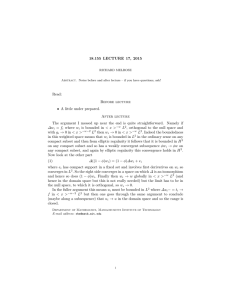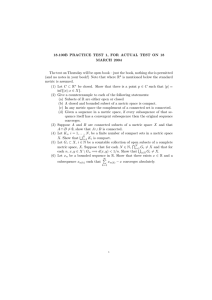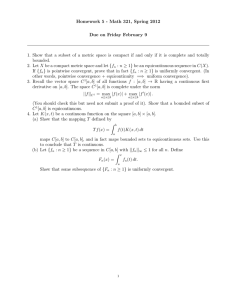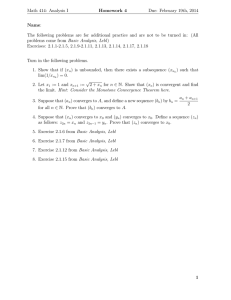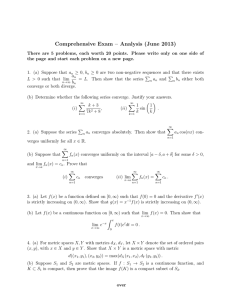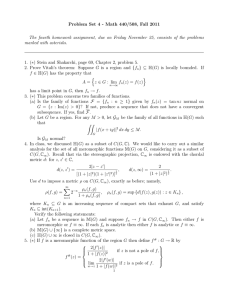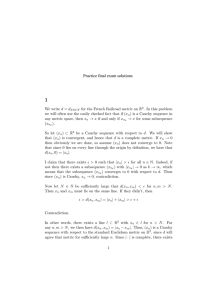Compactness and Continuity
advertisement
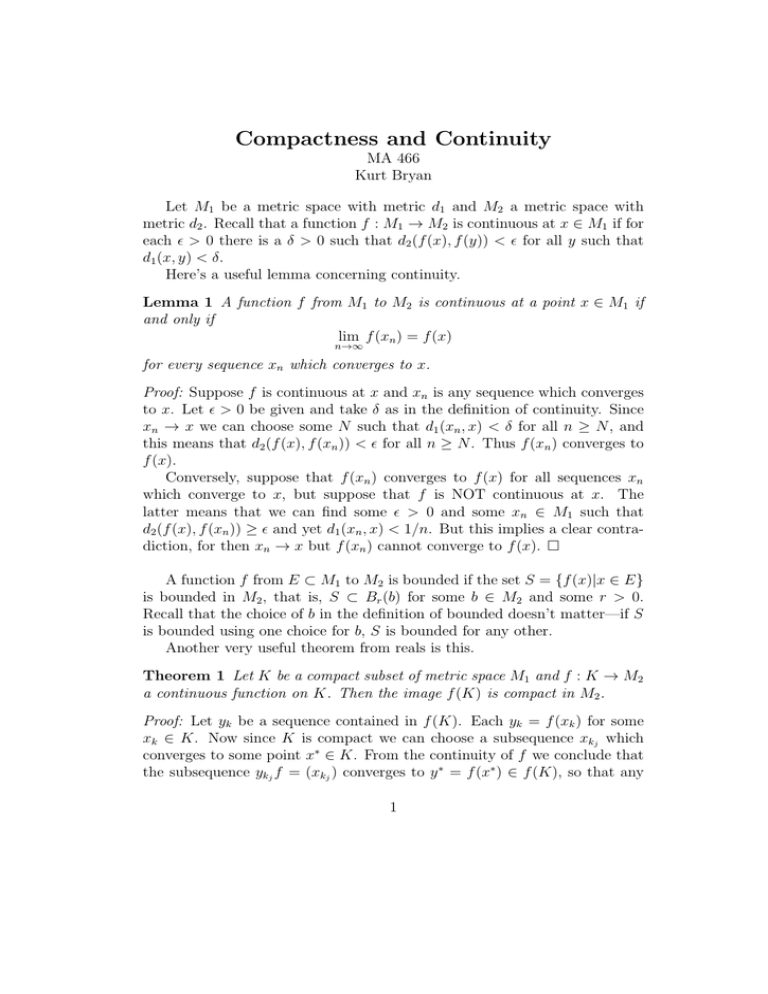
Compactness and Continuity
MA 466
Kurt Bryan
Let M1 be a metric space with metric d1 and M2 a metric space with
metric d2 . Recall that a function f : M1 → M2 is continuous at x ∈ M1 if for
each ϵ > 0 there is a δ > 0 such that d2 (f (x), f (y)) < ϵ for all y such that
d1 (x, y) < δ.
Here’s a useful lemma concerning continuity.
Lemma 1 A function f from M1 to M2 is continuous at a point x ∈ M1 if
and only if
lim f (xn ) = f (x)
n→∞
for every sequence xn which converges to x.
Proof: Suppose f is continuous at x and xn is any sequence which converges
to x. Let ϵ > 0 be given and take δ as in the definition of continuity. Since
xn → x we can choose some N such that d1 (xn , x) < δ for all n ≥ N , and
this means that d2 (f (x), f (xn )) < ϵ for all n ≥ N . Thus f (xn ) converges to
f (x).
Conversely, suppose that f (xn ) converges to f (x) for all sequences xn
which converge to x, but suppose that f is NOT continuous at x. The
latter means that we can find some ϵ > 0 and some xn ∈ M1 such that
d2 (f (x), f (xn )) ≥ ϵ and yet d1 (xn , x) < 1/n. But this implies a clear contradiction, for then xn → x but f (xn ) cannot converge to f (x). A function f from E ⊂ M1 to M2 is bounded if the set S = {f (x)|x ∈ E}
is bounded in M2 , that is, S ⊂ Br (b) for some b ∈ M2 and some r > 0.
Recall that the choice of b in the definition of bounded doesn’t matter—if S
is bounded using one choice for b, S is bounded for any other.
Another very useful theorem from reals is this.
Theorem 1 Let K be a compact subset of metric space M1 and f : K → M2
a continuous function on K. Then the image f (K) is compact in M2 .
Proof: Let yk be a sequence contained in f (K). Each yk = f (xk ) for some
xk ∈ K. Now since K is compact we can choose a subsequence xkj which
converges to some point x∗ ∈ K. From the continuity of f we conclude that
the subsequence ykj f = (xkj ) converges to y ∗ = f (x∗ ) ∈ f (K), so that any
1
sequence in f (K) has a convergent subsequence. Thus f (K) is compact. Of course this means that f (K) is closed and bounded. The latter shows
that a continuous function on a compact set is necessarily bounded.
Here’s a nice fact from reals that also extends:
Theorem 2 Let K be a compact subset of metric space M1 and f : K → lR
a continuous function on K. Then f attains it’s maximum value at some
point in K.
Proof: We know from the previous theorem that f is bounded; let M =
supx∈K f (x). We’ll show that f (a) = M for some point a ∈ K.
To see this, choose a sequence xn ∈ K such that M − 1/n < f (xn ) ≤ M .
Since K is compact, we can extract a subsequence xnk which converges to
some point a ∈ K. Since f is continuous we have, by Lemma 1,
f (a) = lim f (x).
nk →∞
But the right side above clearly converges to M , so f (a) = M . Here’s a little something to think about: Why is f in the last theorem
required to have lR as its range, instead some arbitrary metric space?
Let E ⊂ M1 . A function f defined on E is continuous on E if f is
continuous at each point in E. A function f is uniformly continuous on E if
f is continuous at each x ∈ E and for any ϵ in the continuity definition the
δ can be chosen independently of x. In short, for any given ϵ we can choose
δ in a “one size fits all x” fashion.
Here’s a theorem from real analysis that generalizes to the present setting.
Theorem 3 Let K be a compact subset of metric space M1 and f : K → M2
a continuous function on K. Then f is uniformly continuous.
Proof: We’ll do a proof by contradiction: Suppose that f is not uniformly
continuous. Then for any ϵ > 0 we can find points xn and yn in K such
that d1 (xn , yn ) < 1/n but d2 (f (xn ), f (yn )) ≥ ϵ. Since K is compact we can
extract subsequences xnk and ynk which converge to points in K; indeed, both
subsequences must converge to the same point a, since d1 (xnk , ynk ) < 1/nk .
Since f is continuous at each point in K we must have (by Lemma 1)
lim f (xnk ) = f (a) = lim f (ynk )
k→∞
k→∞
which is clearly impossible since d2 (f (xnk ), f (ynk )) ≥ ϵ. We conclude that f
must be uniformly continuous. 2
